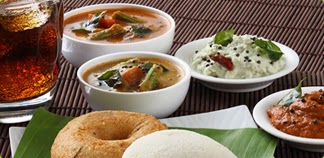Considered as one of the world's most diverse cuisine, Indian cuisine is truly varied and diverse. The food dishes from this country is characterized by the sophisticated use of spices, vegetables, grains and spices. Also, each region has a wide and comprehensive collection of dishes and cooking techniques that are unique to their own state and area. India's religious and ethical beliefs have also played an important part in the overall growth and development of its cuisine. As vegetarianism is an integral part of many religious sects and beliefs, this is widely reflected in the cuisine of the country as well.
Over the years, India has been subject to a number of invasions. All this immigration and intermingling of cultures through the decade but obviously impacted the cooking technique and culinary culture of the country. Many recipes can be traced back to the initial Vedic period where a normal diet consisted of items like vegetables, fruits, meat, dairy products and honey. As this was a predominantly Hindu period, the concept of ahimsa was prevalent which forbade the killing of animals. So a lot of the diet in this period was vegetarian in nature, a concept that was reinforced with the advent of Buddhism as well. As time passed, invasions from Central Asia, Arabia, the Mughal empire, and Persia, had a fundamental effect on Indian cooking. The Islamic conquest of medieval India introduced many new fruits such as apricots, melons, peaches, and plums to the Indian cooking.
This conquest also meant the beginning of a new range of non-vegetarian dishes like rich gravies, pilafs and non-vegetarian fare such as kebabs, giving rise to Mughlai cuisine (Mughal in origin). As the Mughals were big patrons of cooking, cooking techniques and recipes reached a new high during this period with lavish dishes were prepared during the reigns of Mughal rulers especially Jahangir and Shah Jahan. It was during this period that there was a blending of Mughlai and Telangana cuisines in the kitchens of the Nizams who were the historic rulers of Hyderabad state. This resulted in the creation of Hyderabadi biryani, a traditional celebratory meal made using goat meat, basmati rice, yoghurt, onions, and spices. Further, India's diverse climate which range from tropical to cold has made a wide range of ingredients easily available to all cooking enthusiasts. This has resulted in a range of cooking flavors, techniques and dishes that today form an integral part of Indian cuisine.
Indian cuisine is divided into four integral divisions namely North, East, West and South. The cuisine of North India has a predominance of dairy products like milk, paneer, ghee and yoghurt. Most of the dishes of this regions are gravy-based and some of the staple food include a variety of lentils, vegetables, and roti (wheat based bread). Further, Mughlai cuisine forms an integral part of the food habits of this region. The East of India is popular for its sweets and deserts like sandesh, rasgulla, chhena gaja among many others. These dishes are now popular in many other parts of the country as well. Over all Bengali cuisine is balanced and some popular dishes include rice, pantabhat, doi-chirey, doodh-muree and fish. The menu of South Indian cuisine is marked by a greater emphasis on rice as the staple grain and the liberal use of coconut, particularly coconut oil and curry leaves. Some of the popular dishes include different variations of sambar and rasam, a variety of pickles, dosa, poori, idli, vada, bonda and bajji.
These dishes from South India form a major crux of their cuisines and are today popular in many South Indian food restaurant as well. South Indian food is also extremely diverse and rich with some dishes like the dosa gaining popularity all over the world. Today, the popularity of dosa is such that there are many dosa restaurants that have opened up all across the country in order to cater to the growing demand. The western part of India comprises of three food groups namely Gujarati, Maharashtrian and Goan. There are two main types of Maharashtrian cuisine, defined by geographical divisions. The coastal regions consume more rice, coconut, and fish while the the hilly regions of the Western Ghats and Deccan plateau consume more of jowar and bajra. On the other hand, Goan food is a amalgamation of various types of sea food which forms the crux of their cuisine.
Gujarati cuisine is predominantly vegetarian and many of their dishes have a hint of sweetness due to the usage of sugar. And lastly, food from the North East is very different from that of other parts of India. North Eastern cuisine is strongly influenced by neighboring Burma and the China, and therefore their dishes uses very little of Indian spices and techniques.
Over all Indian cuisines is extremely rich, diverse and comprehensive. With such a lot of influences and patronage by different rulers, Indian cuisines is extremely popular and well-know in many regions around the world. With dishes that suit different palates, Indian cuisine has something to offer to everyone.
Source: http://goarticles.com/article/The-Rich-Diversity-And-History-Of-Indian-Cuisine/9576205/






